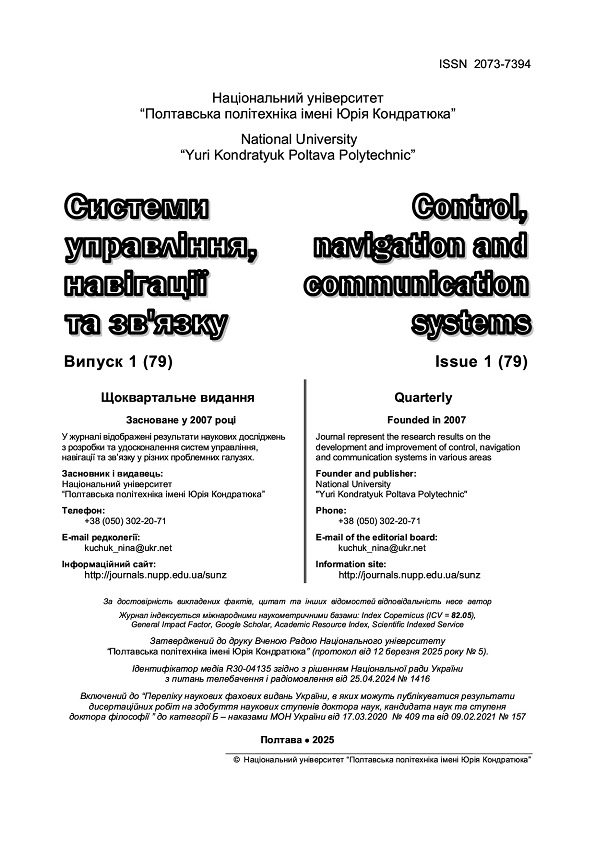Model for planning routes for a homogeneous group of unmanned aerial vehicles
DOI:
https://doi.org/10.26906/SUNZ.2025.1.17-22Keywords:
unmanned aerial vehicle, genetic algorithms, information technologies, trajectory optimization, planning of UAV group movement routes, air traffic control, artificial intelligenceAbstract
The article determines that currently there are a significant number of models and methods that allow for effective planning of UAV movement routes to perform tasks, however, the next stage in the development of robotic technologies is the collective use of heterogeneous systems to perform common tasks. Simultaneous arrival at the required location or locations is one of the elements of mission execution that requires joint planning and coordination between UAVs in the group. The mission objective is that the UAV group must reach the destination simultaneously, which is achieved by creating trajectories of equal length, assuming that all UAVs fly at the same speed. The article further develops a model for planning the routes of a homogeneous group of unmanned aerial vehicles, which, unlike existing ones, takes into account the limitations and requirements for UAV safety and ensures the simultaneous arrival of the group to the final point of the mission. The planning model has three stages, taking into account the maximum curvature constraint and collision avoidance. In the first stage, permissible routes are created, in the second stage, the resulting routes are modified to obtain routes with safety constraints. In the third stage, routes of equal length are created. A route planner scheme and a flowchart of the algorithm for simultaneous arrival of UAVs at the destination are developed. Methods based on Dubins curves, hodographic curves, clothoid trajectories are used to construct UAV movement routes and coordinate the actions of the group to complete the mission. The speed of model calculations can be accelerated by using a global planner to create waypoints and/or positions or by creating intermediate waypoints.
Downloads
References
1. Chodnicki, M.; Siemiatkowska, B.; Stecz, W.; St ˛epie ´n, S. Energy Efficient UAV Flight Control Method in an Environment with Obstacles and Gusts of Wind. Energies 2022, 15. DOI: https://doi.org/10.3390/en15103730
2. Huang, G.; Hu, M.; Yang, X.; Lin, P. Multi-UAV Cooperative Trajectory Planning Based on FDS-ADEA in Complex Environments. Drones 2023, 7, 55. https://doi.org/10.3390/ drones7010055 DOI: https://doi.org/10.3390/drones7010055
3. Liu, Y.; Zhang, F.; Huang, P.; Zhang, X. Analysis, Planning and Control for Cooperative Transportation of Tethered MultiRotor UAVs. Aerosp. Sci. Technol. 2021, 113, 106673. DOI: https://doi.org/10.1016/j.ast.2021.106673
4. Xu, L.; Cao, X.; Du, W.; Li, Y. Cooperative Path Planning Optimization for Multiple UAVs with Communication Constraints. Knowl. Based Syst. 2022, 129, 110164. DOI: https://doi.org/10.1016/j.knosys.2022.110164
5. NataliiaYeromina, Tarshyn, V., Petrov, S., Samoylenko, V.T., Tabakova, I., Dmitriiev, O., Surkova, K., Danylko, O., Kushnierova, N., Soroka, M., Salo, N., & Chumak, O. (2021). Method of reference image selection to provide high-speed aircraft navigation under conditions of rapid change of flight trajectory. International Journal of Advanced Technology and Engineering Exploration, Vol 8(85) ISSN (Print): 2394-5443 ISSN (Online): 2394-7454 http://dx.doi.org/10.19101/IJATEE.2021.874814 DOI: https://doi.org/10.19101/IJATEE.2021.874814
6. Tymochko O., Timochko O., Trystan A., Matiushchenko O. and Berezhnyi A. Method of Automated Flight Route Planning for Unmanned Aerial Vehicles to Search for Stationary Objects. 2020 IEEE 11th International Conference on Dependable Systems, Services and Technologies (DESSERT), Kyiv, Ukraine, 2020. P. 242-246. DOI: https://doi.org/10.1109/DESSERT50317.2020.9125084
7. Бережний А. О., Крижанівський І. М. Комплекс задач системи підтримки прийняття рішення на планування маршрутів польотів безпілотних літальних апаратів. Системи управління, навігації та зв’язку. Збірник наукових праць. Полтава, 2020. Вип. 1(59). С. 3–6. DOI:10.26906/SUNZ.2020.1.003. DOI: https://doi.org/10.26906/SUNZ.2020.1.003
8. Бережний А.О., Крижанівський І.М., Барабаш О.В. Метод автоматизованого планування маршрутів безпілотних літальних апаратів з урахуванням виявлення стаціонарних об’єктів. Телекомунікаційні та інформаційні технології. Київ, 2019. Вип. 4(65). С. 90–98. DOI:10.31673/2412- 4338.2019.049098.
9. Aabid, A.; Parveez, B.; Parveen, N.; Khan, S.A.; Zayan, J.; Shabbir, O. Reviews on design and development of unmanned aerial vehicle (drone) for different applications. J. Mech. Eng. Res. Dev. 2022, 45, 53–69.
10. Amici, C.; Ceresoli, F.; Pasetti, M.; Saponi, M.; Tiboni, M.; Zanoni, S. Review of propulsion system design strategies for unmanned aerial vehicles. Appl. Sci. 2021 DOI: https://doi.org/10.3390/app11115209
11. Rojas-Perez, L.O.; Martínez-Carranza, J. On-board processing for autonomous drone racing: An overview. Integration 2021, 80, 46–59. DOI: https://doi.org/10.1016/j.vlsi.2021.04.007
12. Tymochko O., Trystan A., Berezhnyi A., Sotnikov O., Matiushchenko O., Kryzhanivskyi I. Vehicles while Monitoring Behavior of Dynamic Objects in a Forest-Steppe Area. International Journal of Emerging Trends in Engineering Research. 2020. Vol.8, No 7. P. 3208 − 3215. DOI: https://doi.org/10.30534/ijeter/2020/54872020
Downloads
Published
Issue
Section
License

This work is licensed under a Creative Commons Attribution-NonCommercial 4.0 International License.




